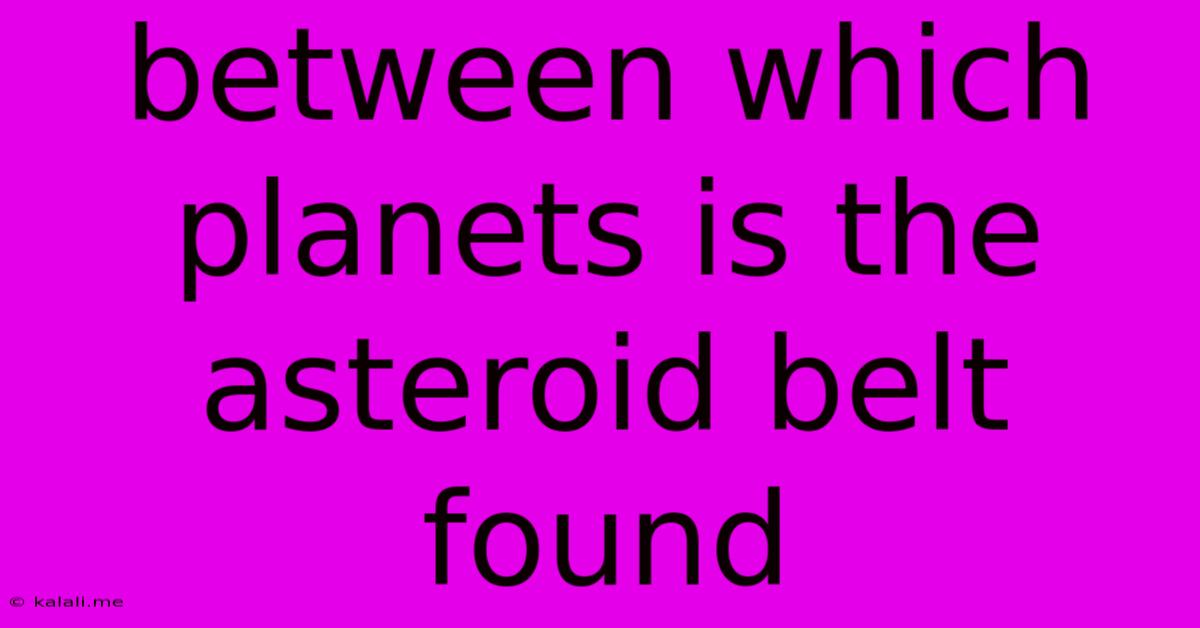Between Which Planets Is The Asteroid Belt Found
Kalali
Jun 14, 2025 · 3 min read

Table of Contents
Where is the Asteroid Belt Located? A Deep Dive into the Solar System's Rocky Realm
The asteroid belt is a fascinating region of our solar system, a vast ring of rocky debris orbiting the Sun. But exactly where is it located? This article delves into the precise location of the asteroid belt, exploring its composition and significance in understanding our solar system's formation.
The Asteroid Belt lies between Mars and Jupiter. This is a crucial fact to remember when studying planetary alignment and the overall architecture of our solar system. Its position is significantly influenced by Jupiter's immense gravitational pull, which prevented the asteroids from coalescing into a planet.
Understanding the Asteroid Belt's Orbit
The asteroid belt isn't a uniformly packed region; instead, it's a relatively sparse collection of asteroids, ranging in size from pebbles to hundreds of kilometers across. The majority of these rocky bodies follow elliptical orbits around the Sun, primarily situated between the orbits of Mars and Jupiter.
- Inner Edge: The inner boundary of the asteroid belt is roughly 2.2 AU (astronomical units) from the Sun. One AU is the average distance between the Earth and the Sun.
- Outer Edge: The outer edge extends to approximately 3.2 AU from the Sun. This region marks a significant shift in the distribution of solar system objects.
Why Isn't There a Planet There?
The prevalent theory suggests that the immense gravitational influence of Jupiter prevented the material in the asteroid belt from accreting into a full-fledged planet. Jupiter's gravity disrupted the orbits of smaller asteroid bodies, preventing them from merging and forming a larger celestial body. Instead, it created a chaotic environment, resulting in the numerous asteroids we observe today.
Types of Asteroids within the Belt
The asteroid belt isn't just a monolithic collection of rocks. It hosts diverse types of asteroids categorized based on their spectral properties:
- C-type asteroids (carbonaceous): These are the most abundant type, dark and rich in carbon. They are thought to be primitive, representing the building blocks of the early solar system.
- S-type asteroids (siliceous): These are made of silicate materials, and are somewhat brighter than C-type asteroids.
- M-type asteroids (metallic): These are believed to be composed primarily of nickel-iron.
Studying the composition of these asteroids provides valuable insights into the early stages of our solar system’s formation and evolution. Their mineral makeup reflects the conditions present during the solar nebula's collapse.
The Asteroid Belt's Ongoing Importance
The asteroid belt continues to be a subject of intense scientific study. Missions like NASA's Dawn spacecraft have provided invaluable data about the composition and geological history of Vesta and Ceres, two of the largest asteroids in the belt. Understanding the asteroid belt is crucial for our understanding of the solar system's formation, planetary evolution, and even for potential future resource utilization. The belt serves as a window into the past, offering clues about the early solar system's processes and conditions. Further exploration of this region promises even more intriguing discoveries in the years to come.
Latest Posts
Latest Posts
-
Least Common Multiple Of 42 And 56
Jun 14, 2025
-
Difference Between A Sequence And Series
Jun 14, 2025
-
Elements Across A Period Have The Same Number Of
Jun 14, 2025
-
List All The Factors Of 15
Jun 14, 2025
-
Bourdon Gauges Are Commonly Used To Measure
Jun 14, 2025
Related Post
Thank you for visiting our website which covers about Between Which Planets Is The Asteroid Belt Found . We hope the information provided has been useful to you. Feel free to contact us if you have any questions or need further assistance. See you next time and don't miss to bookmark.